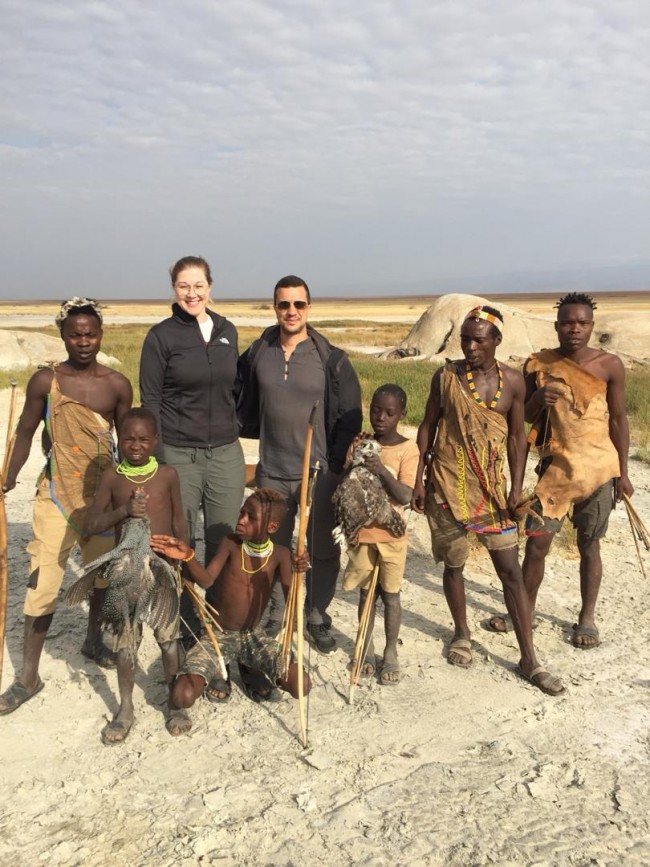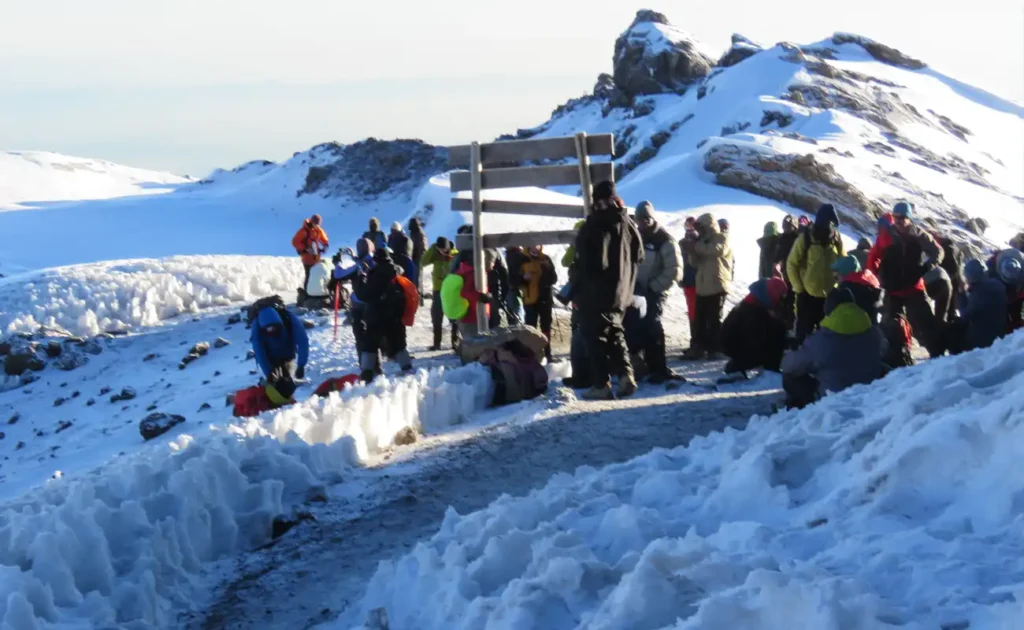Despite the intricate map of thousands of cultures worldwide, fewer than 1,000 Hadzabe people remain in Tanzania, making their community one of the rarest on the planet. A visit to the Hadzabe tribe offers an unparalleled lens into a way of life virtually untouched by modern influences. Here, you are not just a spectator but an active participant, integrating into their daily activities.
Rooted in the rugged landscapes around Lake Eyasi, the Hadzabe have sustained a hunter-gatherer lifestyle for over 40,000 years. They depend on bows and arrows crafted meticulously by hand for sustenance. Remarkably, every aspect of their existence— from their egalitarian social structure to communal sharing of food—is a testament to ecological balance and community resilience.

Hadzabe Tribe Visit: A Dive into Ancient Ways of Life
Visiting the Hadzabe tribe is like stepping back into a time where nature and humanity are in perfect harmony. The Hadzabe live in the stunning landscape near Lake Eyasi, Tanzania, their lifestyle remarkably unchanged by modern influences. According to this post, exploring their world offers a rare glimpse into ancient traditions. This community relies on hunting and gathering, crafting tools from the land around them. Observing them hunt with handmade bows is an unforgettable experience.
Engaging with the Hadzabe tribe allows travelers to experience their daily routines firsthand. Many visitors find it fascinating to see how the tribe uses plants for medicine and food. During the visit, guests can take part in traditional dances around the campfire. They also learn about the Hadzabe’s unique language, which features click sounds. It offers a truly immersive cultural exchange.
The Hadzabe tribe’s relationship with nature is both practical and spiritual. Their survival depends on understanding the landscape and weather patterns. Key survival skills, like tracking animals and identifying plant species, are passed down through generations. These skills highlight the deep knowledge the tribe has of their environment. According to the article, these unique insights are part of what makes visiting Tanzania’s tribes so compelling.
For anyone visiting Tanzania, scheduling a Hadzabe tribe visit can be a life-changing experience. The visit enables travelers to appreciate a culture that prioritizes community and coexistence with nature. Observing their way of life can make one more mindful of our own use of resources. It’s an invitation to reflect on the balance between modern conveniences and sustainability. A journey to the Hadzabe tribe captures the essence of adventure and history.
Understanding the Hadzabe Lifestyle
The Hadzabe lifestyle is a beautiful tapestry woven from freedom and simplicity. This indigenous group thrives without reliance on farming or livestock, living off the land. They roam vast hunters’ territories, adjusting based on seasons and game. In today’s world, such an existence may seem improbable, yet the Hadzabe’s way of life has persisted for thousands of years. It offers insights into a harmonious relationship with nature that is rarely seen elsewhere.
Communication among the Hadzabe is vibrant and fascinating. Their language features unique click sounds, part of a broader group of click languages. This vocal element underscores their cultural uniqueness and rich heritage. It adds to the depth of their social interactions and community ties. Observing them converse is like witnessing a special dance of sounds.
Despite modern influences creeping ever closer, the Hadzabe maintain traditional practices. They expertly craft tools, clothing, and shelter from natural materials. Here’s a brief look at some of these activities:
- Hunting with bows and arrows
- Gathering fruits and roots
- Using animal hides for clothing
- Building huts from grass and branches
These practices highlight their resourcefulness and self-sufficiency.
For the Hadzabe, every day is an adventure driven by survival and community bonding. They share meals, tasks, and celebrations, forging strong communal ties. Storytelling, music, and dance play vital roles in passing down knowledge and beliefs. This vibrant lifestyle fosters a deep connection among tribe members. Understanding these facets enriches any visit to their world.
Encounter with Wildlife during a Hadzabe Tribe Visit
On a visit to the Hadzabe tribe, wildlife encounters are both thrilling and educational. The tribe’s land near Lake Eyasi is home to various animals like baboons, giraffes, and birds. Daily interactions with these creatures form an integral part of the Hadzabe’s life. Witnessing their tracking skills offers insights into natural ecosystems. These moments highlight the rich biodiversity of the region.
For the Hadzabe, hunting is not merely about survival, it’s an art form. The tribe members showcase exceptional skills, using handcrafted weapons to stalk game. Hunting expeditions are opportunities for visitors to observe the Hadzabe’s harmonious coexistence with nature. Every step taken is with respect for the land and its inhabitants. This deep connection enriches the wildlife experience.
Besides large mammals, the Hadzabe environment is filled with vibrant insect life and plant species. Tiny ants, colorful butterflies, and buzzing bees are often seen during walks. Certain plants hold medicinal value and are used by the tribe. Learning about these lesser-known aspects of the environment adds depth to the excursion. It’s amazing how everything has its place in the ecosystem.
Immersing in the Hadzabe’s world offers lessons in balance and respect for all living things. Visitors leave with newfound appreciation for nature’s complexity. It’s not just about seeing animals, but understanding their roles in a larger picture. This experience invokes a sense of wonder and awareness. Observing the world through the Hadzabe’s eyes reveals the beauty of interconnected life.
Cultural Immersion Experiences on a Hadzabe Tribe Visit
Engaging in a cultural immersion experience with the Hadzabe tribe allows travelers to truly connect with their way of life. Visitors often participate in daily activities like gathering plants and preparing food. This hands-on approach provides valuable insights into their survival skills and traditions. It’s an opportunity to learn by doing. These moments are both educational and deeply memorable.
One of the highlights for many visitors is taking part in traditional dance ceremonies. These dances are not just performances, but vital expressions of the tribe’s cultural identity. Participation fosters a sense of shared joy and unity. The rhythmic beats and chants create an immersive and vibrant atmosphere. It’s an experience that resonates long after the visit ends.
Storytelling sessions around the campfire are another essential aspect of the Hadzabe cultural experience. Elders share mesmerizing tales that encapsulate the tribe’s history, values, and beliefs. These stories are passed down generations and offer a glimpse into the tribe’s rich oral traditions. Listening to these narratives under the star-lit sky is magical. It provides a deep understanding of the Hadzabe’s connection to their heritage.
Visitors are also introduced to the Hadzabe’s unique click language. Learning a few basic phrases adds depth to the interaction. This linguistic immersion helps bridge the gap between different cultures. Tourists often find it fascinating to witness these clicks in casual conversation. It enhances the authenticity of the cultural exchange.
The Hadzabe’s craftsmanship, seen in their handmade tools and jewelry, is another captivating aspect. Tourists can try their hand at making simple items using traditional methods. This interactive experience offers insights into the ingenuity and resourcefulness of the tribe. Creating something with your own hands, guided by an expert, is incredibly rewarding. It’s a tangible way to appreciate the Hadzabe’s skills.
Taking part in these cultural immersion activities leaves visitors with a profound respect for the Hadzabe’s way of life. It fosters a deeper appreciation for cultural diversity and sustainability. By participating in their daily practices, travelers gain a unique perspective. It’s a reminder of the beauty and simplicity of life. Such experiences are transformative, making them a must-do on any trip to Tanzania.
The Survival Skills of the Hadzabe People
The Hadzabe people are experts in survival, utilizing skills honed over thousands of years. Their ability to find food in the harsh environment of northern Tanzania is awe-inspiring. With handcrafted bows and poison-tipped arrows, they hunt game such as baboons and antelope. They also gather a variety of fruits, roots, and honey. This method ensures a balanced diet throughout the year.
Tracking animals is a crucial survival skill for the Hadzabe. They read the land like a book, interpreting tracks and signs left by animals. This knowledge allows them to hunt efficiently and sustainably. Every mark on the ground tells a story. It is a testament to their deep connection with the natural world.
The tribe’s ability to use plants for medicinal purposes is another significant survival skill. They know which plants can treat ailments like infections, wounds, or stomach issues. Learning from the Hadzabe offers valuable insights into natural medicine and holistic health. This knowledge has been passed down through generations. It is vital to their way of life and survival.
Water sourcing is essential in the dry regions they inhabit. The Hadzabe are skilled at locating water from seemingly barren land. They dig for hidden underground sources and collect rainwater in natural containers. These techniques are crucial during dry seasons. It showcases their adaptability and resourcefulness.
Fire-making is another indispensable skill. Using friction methods, they can create fire without modern tools. Fire is used for cooking, warmth, and protection. This age-old technique remains a vital part of their daily routine. Mastering this skill demonstrates their ingenuity and self-reliance.
These survival skills reflect the Hadzabe’s deep understanding of their environment. They live in harmony with nature, taking only what they need. Each skill is a lesson in resilience and sustainability. Observing the Hadzabe people can inspire a more mindful relationship with the natural world. Their way of life offers invaluable lessons for anyone interested in survival and indigenous knowledge.
The Spiritual Beliefs and Rituals of the Hadzabe Tribe
The Hadzabe tribe holds spiritual beliefs deeply intertwined with their natural surroundings. Their spirituality isn’t dominated by a single god but rather a connection to nature itself. They believe that everything, from the ground beneath their feet to the stars above, contains a spirit. These beliefs guide their everyday life and decision-making processes. It fosters a sense of respect and responsibility for the environment.
In times of celebration or need, the Hadzabe perform various rituals and ceremonies. One of the most significant rituals involves dancing around a fire, chanting and clapping to call upon spiritual forces. This communal dance helps strengthen bonds among tribe members and connects them with ancestral spirits. The ritual is more than just tradition; it’s a vital expression of unity and identity. Observers often find these ceremonies both captivating and enlightening.
Shamans, or spiritual leaders, play a crucial role in the tribe. They guide rituals, offer healing, and communicate with the spiritual realm. Their wisdom is respected, and they perform important ceremonies to bless hunts or harvests. Shamans are trained through years of experience and learning from the elder members. They are central figures in maintaining the spiritual and cultural heritage of the tribe.
The Hadzabe also rely on natural symbols to convey spiritual meanings. For instance, certain animals and plants feature prominently in their stories and rituals. These symbols serve as reminders of their beliefs and values. Understanding these elements offers a window into the tribe’s spiritual worldview. It’s a fascinating blend of everyday life and spiritual awareness.
For the Hadzabe, spirituality is not separate from their daily activities. It influences their interactions with each other and their environment. Through rituals and beliefs, they cultivate a harmonious balance with nature. Visitors who experience these practices leave with a deeper appreciation of cultural diversity and spirituality’s role in everyday life. The Hadzabe’s spiritual beliefs and rituals offer timeless lessons in respect, balance, and harmony.

Frequently Asked Questions
Many people are curious about the unique experiences and cultural insights offered by a visit to the Hadzabe tribe. Below are some frequently asked questions that delve deeper into their way of life and what to expect during such an enriching journey.
1. What is the social structure of the Hadzabe tribe?
The Hadzabe tribe operates on an egalitarian social structure, where decisions are made jointly, and there are no formal chiefs or hierarchies. This system ensures that resources such as food are shared equally among tribe members, fostering a strong sense of community and cooperation. Their structure contrasts with many modern societies, showcasing an integrated way of life rooted in equality and mutual respect.
Such a structure means that everyone, regardless of age or gender, has a voice in communal decisions. This democratic setup allows for open dialogue, making community gatherings a pivotal aspect of their culture. Consequently, their approach to leadership and resource distribution highlights a sustainable and collective endeavor that emphasizes unity and support.
2. How do the Hadzabe practice sustainable living?
The Hadzabe tribe maintains sustainability through their hunter-gatherer lifestyle, relying on nature’s offerings without overexploitation. This involves hunting only what is needed and gathering fruits, honey, and roots, ensuring that no resources are depleted. Their practices reflect an innate respect for nature, which guides their daily decisions and sustains their environment.
The ability to read natural cues and signs allows them to efficiently locate water and game, vital for survival in their arid region. By living in harmony with the land and maintaining ecological balance, the Hadzabe people embody sustainability long before it became a global conversation. Their practices serve as a model for coexisting with the earth responsibly.
3. What role do women play in Hadzabe society?
Women in the Hadzabe community play a crucial role, contributing significantly to food gathering, child-rearing, and communal leadership. They gather fruits, plants, and tubers, which form a substantial part of their diet, underscoring the importance of their contributions to group survival. Women also engage in decision-making processes, adding diverse perspectives to the tribe’s collective wisdom.
Gender roles, although distinct, overlap at times, allowing both men and women to assist each other in various tasks. This flexibility elevates the status of women within their society. The balance of responsibilities reflects a shared focus on the wellbeing of the whole community, blending traditional roles with a sense of equality and partnership.
4. What should visitors expect during a cultural exchange with the Hadzabe?
Visitors to the Hadzabe tribe can expect an interactive and immersive cultural exchange that may include participating in hunting expeditions and traditional dance ceremonies. Engaging in these activities offers insights into their profound connection with the natural world. Guests often find it to be an enriching, humbling experience that broadens their understanding of different cultural practices.
Beyond activities, listening to their captivating stories around the campfire and learning elements of their click language provides deeper cultural appreciation. Such exchanges foster mutual respect and understanding, making the visit more than just an observation—it’s an opportunity to build a bridge between different worlds. This hands-on experience is as educational as it is memorable.
5. How has the Hadzabe tribe resisted modernization?
The Hadzabe tribe preserves their ancient ways by maintaining traditional practices despite external pressures to modernize. Their remote location and self-reliant lifestyle shield them from many modern influences. Their commitment to retaining ancestral customs reflects a strong desire to protect their cultural identity from dilution or transformation.
While interactions with tourists occur, they derive benefits without significantly altering their fundamental lifestyle. This balance showcases their resilience in preserving an authentic way of life amidst growing global influences. By staying true to their roots, the Hadzabe remain a living testament to the possibility of thriving without succumbing to modern distractions.



